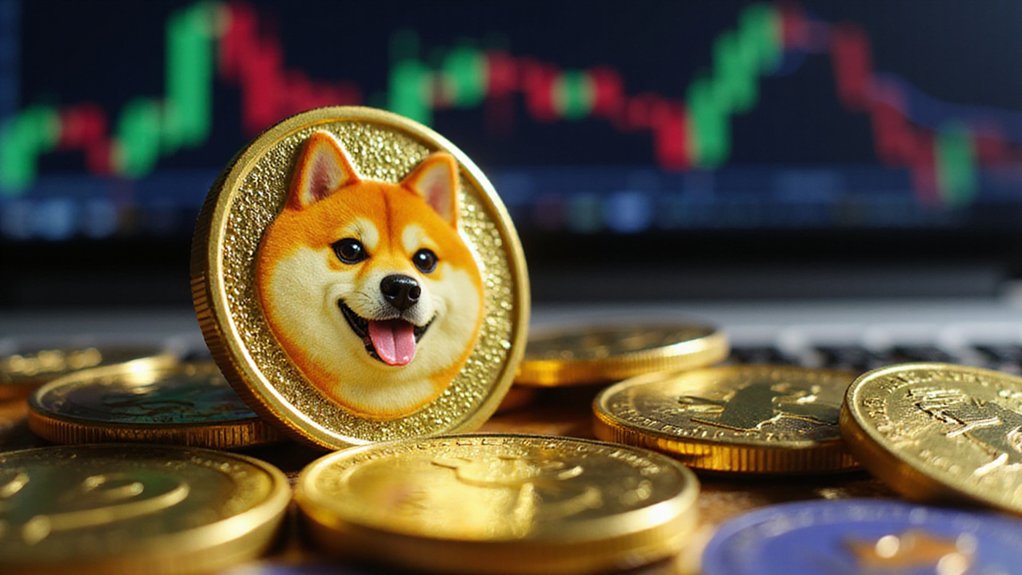Meme coins are cryptocurrencies inspired by internet jokes rather than technological innovation, exemplified by Dogecoin’s Shiba Inu origins. Unlike Bitcoin or Ethereum, these digital assets prioritize community appeal and virality over utility, creating tight-knit online communities through shared humor. Despite minimal practical applications, meme coins have achieved remarkable market capitalizations, though they remain exceptionally volatile—subject to celebrity-driven price swings and potential regulatory scrutiny. Their peculiar blend of digital tribalism and speculative fervor offers a fascinating window into contemporary financial psychology.

Why have cartoon dogs and internet jokes suddenly become billion-dollar digital assets?
The answer lies in the peculiar intersection of internet culture, cryptocurrency speculation, and collective behavioral economics that has birthed the phenomenon known as “meme coins.”
These digital currencies—inspired by internet memes rather than technological innovation—represent a distinctive subset of cryptocurrencies that prioritize community appeal and virality over utility or intrinsic value.
Meme coins originated as lighthearted alternatives to mainstream cryptocurrencies, with Dogecoin (based on the popular Shiba Inu “Doge” meme) emerging as the archetypal example.
Dogecoin pioneered the meme coin revolution, transforming internet humor into cryptocurrency speculation with surprising market impact.
Unlike Bitcoin or Ethereum, which were conceived with specific technological purposes, meme coins openly embrace their humorous origins and often lack substantive use cases beyond trading and speculation.
This absence of utility, paradoxically, hasn’t prevented them from occasionally achieving staggering market capitalizations.
The popularity of meme coins has expanded beyond Dogecoin to include other notable tokens like Shiba Inu coin and Pepe Coin that have gained significant investor attention.
The ecosystem surrounding these tokens exhibits notable volatility, characterized by rapid price fluctuations driven more by social media sentiment than fundamental analysis.
Investors—if one can employ that term without significant qualification—are frequently drawn to these assets through celebrity endorsements or community enthusiasm rather than due diligence.
The regulatory environment remains nebulous at best, creating fertile ground for pump-and-dump schemes and other market manipulations.
The regulatory concerns were highlighted when Thailand’s Securities and Exchange Commission banned meme coins in early 2021, citing their lack of substance as the primary reason.
Despite their dubious investment credentials, meme coins serve several functions within the broader cryptocurrency landscape.
They introduce newcomers to blockchain concepts, create tight-knit online communities, and occasionally function as laboratories for governance experiments.
The participatory nature of meme coin communities—where holders contribute memes, promote tokens, and recruit new participants—represents a form of digital tribalism previously unseen in financial markets.
These communities engage with their preferred tokens through specialized cryptocurrency wallets that provide access to various blockchain networks where meme coins operate.
Financial experts universally advise approaching meme coins with extreme caution.
Their speculative nature, combined with minimal liquidity and regulation, renders them particularly susceptible to catastrophic devaluations.
Nevertheless, they persist as cultural artifacts that illuminate the sometimes absurd intersection of internet culture and financial speculation—where a cartoon dog can, albeit briefly, become more valuable than established multinational corporations.
Frequently Asked Questions
How Do I Evaluate a Meme Coin’s Long-Term Potential?
Evaluating a meme coin’s longevity requires analyzing factors beyond the initial hype cycle.
Investors should scrutinize community engagement sustainability, developer commitment evidenced through ongoing technical improvements, and potential utility beyond memetic appeal.
Market capitalization and liquidity patterns—particularly during market downturns—reveal resilience, while regulatory compliance signals legitimacy.
Smart money examines tokenomics closely, particularly concentrated holdings that suggest potential manipulation.
The rare successful meme coin transforms from novelty into ecosystem participant through consistent development and adoption.
Can Meme Coins Serve Any Real Technological Purpose?
While meme coins ostensibly lack technological innovation, they occasionally serve peripheral tech purposes.
Their community-building capacity functions as a gateway for blockchain adoption, potentially drawing developers who might otherwise avoid cryptocurrency ecosystems.
Some projects experiment with governance models or tokenomics that inform broader research.
However, their technological contributions remain largely incidental rather than intentional—the digital equivalent of a laboratory side effect that accidentally yields more interesting results than the primary experiment itself.
What Regulations Currently Affect Meme Coin Investments?
Meme coin investments currently exist in a regulatory twilight zone. The SEC’s Division of Corporation Finance has issued non-binding guidance suggesting these speculative digital assets don’t constitute securities—thus exempting them from federal securities laws’ registration requirements and investor protections. However, this regulatory reprieve (which Commissioner Crenshaw significantly criticized as “incomplete”) doesn’t shield meme coins from other oversight mechanisms, including potential CFTC jurisdiction, anti-money laundering requirements, and various international regulations that continue to evolve alongside these peculiar financial phenomena.
How Do Meme Coins Compare to Stablecoins?
Meme coins and stablecoins represent opposing philosophies in the crypto ecosystem: the former thrives on volatility and social momentum (often devoid of fundamental value), while the latter prioritizes price stability through fiat-pegging mechanisms.
Where stablecoins offer practical utility for transactions and wealth preservation during market turbulence, meme coins present speculative opportunities with corresponding risks.
The choice between them ultimately reflects one’s risk tolerance—seeking the adrenaline rush of potential 1000x returns versus the measured certainty of financial predictability.
What Percentage Should Meme Coins Occupy in a Portfolio?
Financial experts generally recommend limiting meme coin allocation to under 5% of one’s investment portfolio—a ceiling that seems generous considering their spectacular volatility.
Conservative investors might restrict exposure further to 1-3%, acknowledging these assets’ propensity for overnight evaporation.
One’s risk tolerance and portfolio size remain critical factors; larger, well-diversified portfolios might accommodate slightly higher allocations, while smaller ones should exercise additional restraint.
Remember: only allocate what you’re prepared to watch disappear with remarkable efficiency.









